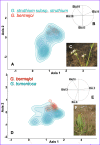Four climate change scenarios for Gypsophila bermejoi G. López (Caryophyllaceae) to address whether bioclimatic and soil suitability will overlap in the future
- PMID: 31194783
- PMCID: PMC6564006
- DOI: 10.1371/journal.pone.0218160
Four climate change scenarios for Gypsophila bermejoi G. López (Caryophyllaceae) to address whether bioclimatic and soil suitability will overlap in the future
Abstract
Climate change has altered the global distribution of many species. Accordingly, we have assessed here the potential shift in the distribution of Gypsophila bermejoi G. López under distinct scenarios of future climate change, this being a species endemic to the Iberian Peninsula. For strict gypsophiles, climatic changes affecting their potential area of distribution could be critical if the new range is not overlapped with suitable soils. Thus, the narrow bioclimatic niche and the endemic nature of this plant could make this species particularly vulnerable to climate change. We used the Maximum Entropy (MaxEnt) method to study the potential distribution of this taxon under four different scenarios of climate change, pin-pointing relevant changes in the potential distribution of this plant and enabling possible future areas of refuge to be assessed. Such scenarios are defined according to four Representative Concentration Pathways (RCPs) [, which represent different trends in the concentration of atmospheric carbon dioxide. As a result, we predict notable changes in the potential distribution of G. bermejoi, and the overlap between soil and bioclimatic suitability would be affected. We also used a Principal Component Analysis (PCA) to model the bioclimatic niche of this species, comparing it with that of its parental taxa. The evolution of bioclimatic suitability was assessed at the current locations of G. bermejoi and as this plant is a strict gypsophile, we generated suitability maps for sites with gypsum soils. Ultimately, this study identifies relevant changes in the potential distribution of G. bermejoi under specific climatic scenarios, observing remarkable differences in the outcomes of the different climate change scenarios. Interestingly, in some scenarios the bioclimatic suitability of G. bermejoi will be enhanced at many locations and even in the worst scenario some possible refuge areas were identified. G. bermejoi behaves more like a hardy survivor than as early victim.
Conflict of interest statement
The authors have declared that no competing interests exist.
Figures







Similar articles
-
Gypsophila bermejoi G. López: A possible case of speciation repressed by bioclimatic factors.PLoS One. 2018 Jan 16;13(1):e0190536. doi: 10.1371/journal.pone.0190536. eCollection 2018. PLoS One. 2018. PMID: 29338010 Free PMC article.
-
Sympatric and allopatric niche shift of endemic Gypsophila (Caryophyllaceae) taxa in the Iberian Peninsula.PLoS One. 2018 Nov 7;13(11):e0206043. doi: 10.1371/journal.pone.0206043. eCollection 2018. PLoS One. 2018. PMID: 30403709 Free PMC article.
-
Using species distribution models to locate the potential cradles of the allopolyploid Gypsophila bermejoi G. López (Caryophyllaceae).PLoS One. 2020 May 19;15(5):e0232736. doi: 10.1371/journal.pone.0232736. eCollection 2020. PLoS One. 2020. PMID: 32428047 Free PMC article.
-
Predicting habitat suitability and niche dynamics of Dactylorhiza hatagirea and Rheum webbianum in the Himalaya under projected climate change.Sci Rep. 2022 Aug 1;12(1):13205. doi: 10.1038/s41598-022-16837-5. Sci Rep. 2022. PMID: 35915126 Free PMC article.
-
Climate change and biological invasions: evidence, expectations, and response options.Biol Rev Camb Philos Soc. 2017 Aug;92(3):1297-1313. doi: 10.1111/brv.12282. Epub 2016 May 31. Biol Rev Camb Philos Soc. 2017. PMID: 27241717 Review.
Cited by
-
Effect of aridity on species assembly in gypsum drylands: a response mediated by the soil affinity of species.AoB Plants. 2020 May 25;12(3):plaa020. doi: 10.1093/aobpla/plaa020. eCollection 2020 Jun. AoB Plants. 2020. PMID: 32547722 Free PMC article.
References
-
- Houghton JT, Ding YD, Griggs D J, Noguer M, van der Linden PJ, Dai X, et al. Climate change 2001: the scientific basis. The Press Syndicate of the University of Cambridge, 2001.
Publication types
MeSH terms
Substances
LinkOut - more resources
Full Text Sources
Medical
Research Materials

